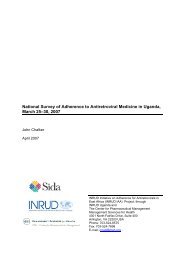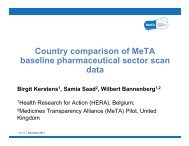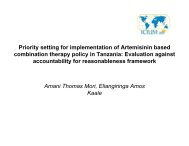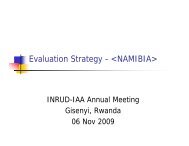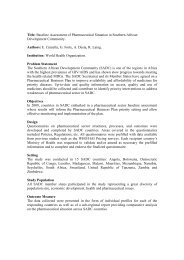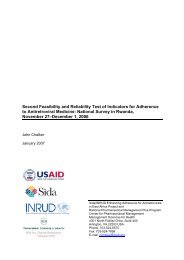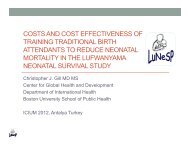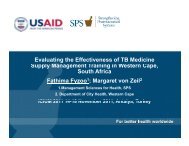How to investigate levels of Adherence to antiretroviral ... - INRUD
How to investigate levels of Adherence to antiretroviral ... - INRUD
How to investigate levels of Adherence to antiretroviral ... - INRUD
You also want an ePaper? Increase the reach of your titles
YUMPU automatically turns print PDFs into web optimized ePapers that Google loves.
Appendix 6<br />
Complementary indica<strong>to</strong>rs <strong>of</strong> determinants <strong>of</strong> adherence<br />
Rationale<br />
Source <strong>of</strong> data<br />
Data collection<br />
Computation<br />
Comments<br />
The number <strong>of</strong> days <strong>of</strong> ARVs dispensed dictates how <strong>of</strong>ten the patient has <strong>to</strong><br />
return <strong>to</strong> the clinic. The more frequent, the more time is sacrificed <strong>to</strong><br />
treatment, but also the more contact the patient has with the clinic. Both <strong>of</strong><br />
these fac<strong>to</strong>rs may affect adherence.<br />
Facility Interview and Retrospective data form.<br />
While doing the facility interview ask whether the clinic has a normal pro<strong>to</strong>col<br />
for the numbers <strong>of</strong> days <strong>of</strong> ARVs dispensed <strong>to</strong> new and <strong>to</strong> experienced<br />
patients. Also observe the most frequent numbers when filling in the<br />
retrospective data form.<br />
New Patients—The stated average number <strong>of</strong> days <strong>of</strong> ARVs dispensed <strong>to</strong> new<br />
patients.<br />
Experienced Patients—The stated average number <strong>of</strong> days <strong>of</strong> ARVs dispensed<br />
<strong>to</strong> experienced patients.<br />
This information can be checked while filling in the retrospective dispensing<br />
data form. If there is a disagreement in the results, what is found on the<br />
dispensing data form will be more accurate.<br />
Facility services and contact with the community<br />
13. The percentage <strong>of</strong> facilities that provide food for patients.<br />
14. The percentage <strong>of</strong> facilities that have a formal system for linking patients with<br />
other persons living with HIV as support partners.<br />
15. The percentage <strong>of</strong> facilities that have connection with the local community, such as<br />
churches or other organizations.<br />
Rationale<br />
Source <strong>of</strong> data<br />
Data collection<br />
Computation<br />
Comments<br />
When poor patients start ART, their appetite improves and they start <strong>to</strong> put on<br />
weight. The increased appetite represents increased cost. This can be<br />
facilitated by the programme providing food <strong>to</strong> the patients during their first<br />
months <strong>of</strong> treatment. With chronic diseases by far the majority <strong>of</strong> the patient’s<br />
time is spent in the community rather than in the facility. Therefore community<br />
support and community linkages are key <strong>to</strong> helping the patient adhere.<br />
Facility interview.<br />
While doing the facility interview ask whether the clinic has a policy for giving<br />
food <strong>to</strong> patients; whether they have a formal system for linking patients with<br />
other persons living with HIV as support partners; and whether they have<br />
connection with the local community, such as churches or other organizations.<br />
Food—Does the facility provide food <strong>to</strong> patients?<br />
Linking patients with other persons living with HIV as support partners—Does<br />
the facility have a formal linking system?<br />
Linkage with the community—Does the facility have active links?<br />
This information can be checked for completeness by asking patients in the<br />
exit interviews.<br />
3. Complementary demographic indica<strong>to</strong>rs<br />
1. Tuberculosis status—Percentage <strong>of</strong> patients with TB comorbidity.<br />
2. WHO disease stage at initiation <strong>of</strong> ARVs: Percentage <strong>of</strong> patients diagnosed as stage I,<br />
II, III and IV at initiation.<br />
147



